If you’re no stranger to the world of fitness and recovery, you’ve probably heard about foam rolling. This simple yet highly effective self-myofascial release technique has taken the health and wellness industry by storm. We will explore the many benefits of foam rolling, how it works, and how you can incorporate it into your fitness routine to improve flexibility, reduce muscle soreness, and enhance overall well-being. At Motion Fit Rehab and Wellness, this is a tool that we recommend for many of our patients to manage their pain and discomfort from home. Whether your are completing strength training, endurance exercise, or working at a desk for prolonged periods, muscle recovery is important to keep you moving well.
What Is Foam Rolling?
Foam rolling, also known as self-myofascial release, is a form of self-massage that involves using a foam roller to apply pressure to various areas of the body. The primary goal is to release tension in the fascia, the connective tissue that surrounds and supports muscles. By rolling over tight or sore muscles, you can help break up adhesions and knots, improving blood flow and promoting muscle recovery.

How Does Foam Rolling Work?
Foam rolling is based on the concept of self-massage and trigger point release. Here’s how it works:
Pressure Application: You use your body weight to apply pressure to specific muscle groups by rolling the foam roller back and forth.
Myofascial Release: As you roll, the pressure on the fascia helps release tight spots and adhesions in the muscle tissue.
Improved Blood Flow: By targeting these areas, you increase blood flow, which can reduce muscle soreness and improve overall muscle function.
Stretching and Relaxation: Foam rolling can also be used for stretching and relaxation, helping to improve flexibility and reduce muscle tension.
Benefits of Foam Rolling
Reduced Muscle Soreness: Foam rolling is an effective way to alleviate muscle soreness and stiffness, making it a popular choice for post-workout recovery.
Improved Flexibility: Regular foam rolling can help improve your range of motion by releasing tight muscles and fascia, making your workouts more effective and reducing the risk of injury.
Enhanced Circulation: The pressure applied during foam rolling promotes blood flow to the muscles, which can aid in the removal of waste products and toxins, further aiding in recovery.
Injury Prevention: By addressing muscle imbalances and tightness, foam rolling can help prevent injuries that may occur due to overuse or improper form during exercise.
Stress Reduction: Foam rolling can have a relaxing effect on the body and mind, making it an excellent addition to your self-care routine.
How to Foam Roll Safely
To reap the benefits of foam rolling while minimizing the risk of injury, follow these tips:
Start Slowly: If you’re new to foam rolling, begin with a softer roller and lighter pressure to avoid excessive discomfort.
Maintain Proper Form: Pay attention to your body positioning and alignment when rolling. Avoid rolling over joints or bones.
Target Specific Areas: Focus on areas that are tight or sore, spending extra time on trigger points.
Breathe: Remember to breathe deeply and relax during the process to enhance the effectiveness of foam rolling.
Stay Hydrated: Proper hydration is essential for muscle health and recovery.
Foam rolling is a versatile and accessible tool that can benefit individuals of all fitness levels. Whether you’re an athlete looking to enhance your performance, someone seeking relief from muscle soreness, or simply interested in improving flexibility and well-being, foam rolling can be a valuable addition to your fitness and self-care routine. In combination with routine strength training, and musculoskeletal care with a chiropractor or physiotherapist, this is a tool that can help you move and feel better.



